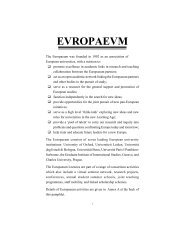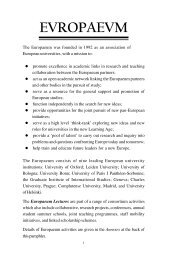Authors Iain Begg | Gabriel Glöckler | Anke Hassel ... - The Europaeum
Authors Iain Begg | Gabriel Glöckler | Anke Hassel ... - The Europaeum
Authors Iain Begg | Gabriel Glöckler | Anke Hassel ... - The Europaeum
Create successful ePaper yourself
Turn your PDF publications into a flip-book with our unique Google optimized e-Paper software.
Energy and carbon use depend on four components (the so-called Kaya<br />
identity): population, GDP per capita, the energy intensity of GDP and the<br />
carbon intensity of energy use. <strong>The</strong> first component is usually assumed to<br />
be exogenous to policymaking, and it is also salient that the bulk of the<br />
projected population growth in the coming decades will be in low income<br />
countries. If only for this reason, lower per capita growth rates – the<br />
second component of the identity - would imply that the poor of the world<br />
would be condemned to remain in poverty, so that any attempt to curb<br />
growth would be contrary to social justice, not to mention incompatible<br />
with commitments to development in the Millennium Development<br />
Goals.<br />
It is therefore in the energy intensity of GDP and in the carbon intensity of<br />
energy that the scope for change lies. It is well established that energy<br />
consumption and GDP are strongly correlated: as countries grow, so too<br />
does their consumption of energy for transport, production, heating and<br />
cooling, and other quality of life purposes. <strong>The</strong>se rates of consumption<br />
have increased steadily over the last two hundred years, especially for the<br />
countries which have grown most, and, today, the richest countries<br />
consume amounts of energy several times those of the poorer countries.<br />
<strong>The</strong> solution is, again, obvious: the relationship between GDP and energy<br />
used needs to be “decoupled”. <strong>The</strong> trouble, though, is that the countries<br />
which, over the next fifty years, are expected to add most to GDP (above<br />
all the most populous emerging economies in Asia) tend to see economic<br />
development as the primary goal and will be reluctant to forgo growth in<br />
the interests of lower emissions.<br />
Even though demand for energy has proved not to be very responsive to<br />
price changes, rising prices will have some effects, notably on the wellbeing<br />
of low income households. For public policy, the result may be calls<br />
for compensatory social transfers, especially for social groups at risk of<br />
“fuel poverty”. To the extent that rising oil prices create windfall gains for<br />
government revenues, such compensation is affordable. Energy mix is<br />
partly about whether to favour renewables or nuclear power, but can also<br />
refer to using hydrocarbons in ways that emit less. In all of this there are<br />
tricky trade-offs: nuclear safety against the uncertainty of renewables; the<br />
unintended consequence that bio-fuels crowd out food production, raising<br />
the price for basic foodstuffs, and so on.<br />
But it is also clear that sizeable commitments of public resources will be<br />
needed to develop the necessary technologies of the future, such as carbon<br />
capture and sequestration, which will require burden-sharing at the global<br />
156<br />
After the crisis: A new socio-economic settlement for the EU

















